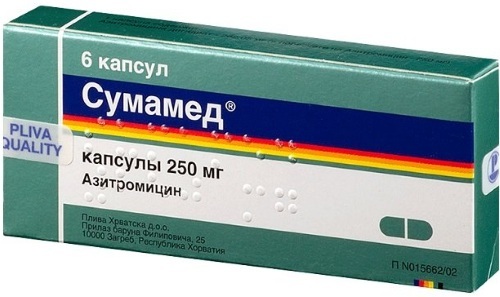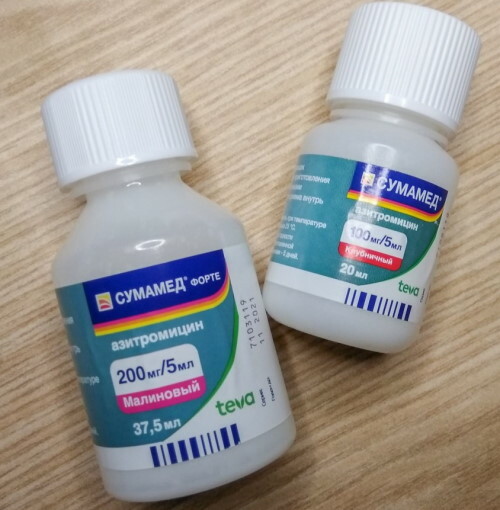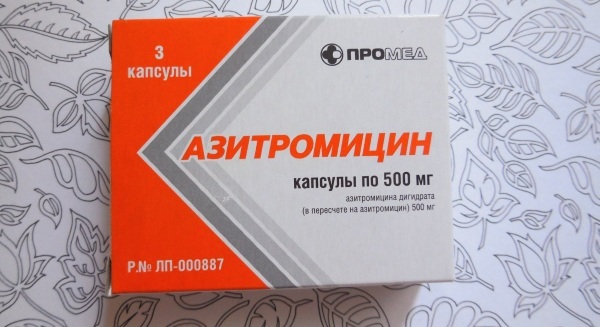Content
- Forms of drug release
- Chemical composition
- Pharmacological properties
- Pharmacodynamics and pharmacokinetics
- Indications for use
- Contraindications
- At what age can the drug be used in children?
- Instructions for use, dosage
- Features of tablet dosing
- Features of capsule dosing
- Features of dosing powder for suspension
- Side effects
- Overdose
- special instructions
- Drug interactions
- Analogs
- Terms, conditions of sale and storage
- Price
- Video about the drug Sumamed
Sumamed is a Croatian antibiotic, which has become widespread due to its high efficiency. Also, the advantage of the medication is a large selection of dosage forms: powder for preparing a suspension, tablets and capsules. All of these types of medicines are allowed to be used to treat children.
Forms of drug release
Sumamed is produced by a pharmaceutical company in 3 dosage forms:
- tablets with a dosage of the active substance in the amount of 125 mg. The tablets have a round and biconvex shape and are covered with a blue shell (the inner content is white). Each tablet is engraved with "PLIVA", as well as the amount of the active ingredient. The blister contains 6 tablets. The carton contains 1 blister and instructions;
- tablets with a concentration of the main element in the amount of 500 mg. The tablets have an oval and biconvex shape, and are blue-coated (white tablet filler). On the tablets there is a proprietary "PLIVA" engraving, as well as the concentration of the main substance. The tablets are packed in a blister in the amount of 3 pcs. The carton contains 1 blister and instructions;
- capsules with a dosage of the active ingredient 250 mg. The capsules have a gelatinous shell and are oval in shape. At the same time, their lid is decorated in blue, and the body is in blue. The capsule contains a white powder with a yellow tint. The capsules are placed in a blister in the amount of 6 pcs. The carton contains 1 blister and instructions;
- powder with a concentration of the main element in the amount of 100 or 200 mg per 5 ml of the finished suspension. The powder is presented in the form of small granules of white color with a yellow tint. The preparation has the aroma of banana and cherry, strawberry or raspberry, and is placed in a plastic jar with a screw cap in the amount of 15.20 or 30 ml. A jar, instructions, and a measuring spoon or syringe are placed in a cardboard box.
Due to the variety of forms, it is convenient to select the desired form of release with the required dosage of the active element.
Chemical composition
Sumamed for children of all forms of release includes one main substance, azithromycin trihydrate (a broad-spectrum antibiotic, semi-synthetic), but in different concentrations. Further, depending on the dosage form, the composition of the auxiliary elements changes.
| Release form | Compound | List of components | Component Description |
| Pills | Contents of the tablet | Anhydrous Calcium Hydrogen Phosphate | The substance is necessary to give the tablet the desired shape. |
| Hypromellose | The element has a lubricating and softening effect. | ||
| Corn starch | The component has an enveloping, anti-inflammatory and healing effect. In addition, starch allows the tablet to dissolve quickly under the action of gastric juice. | ||
| Pregelatinized starch | The component is a filler and allows the tablet to maintain its intended shape. | ||
| Microcrystalline cellulose | The element gives the tablets stability and makes them smooth and durable. In addition, the substance improves the absorption of the active ingredient. | ||
| Sodium lauryl sulfate | The component is a surfactant, it is necessary to give the tablets the desired texture. | ||
| Magnesium stearate | The substance is used as a filler and slows down the disintegration of tablets. | ||
| Shell composition | Hypromellose | The element has a lubricating and softening effect. | |
| Polysorbate 80 | It is a filler and is used to stabilize the texture of the shell. | ||
| Talc | The component facilitates the sliding of the tablet along the digestive tract. | ||
| Titanium dioxide | The element is a thickener and also has bleaching properties. | ||
| Indigo carmine dye | Gives the shell a blue color. | ||
| Capsules | Contents of capsules | Microcrystalline cellulose | The substance does not allow the contents of the capsules to cake and clump. |
| Sodium lauryl sulfate | The component gives the powder the desired shape. | ||
| Magnesium stearate | It is a filler and prevents the particles of the capsule contents from sticking together. | ||
| Shell content | Gelatin | The component allows the capsule to dissolve easily under the action of gastric juice. | |
| Titanium dioxide | Used to make the body light blue instead of blue. | ||
| Indigo carmine dye | Stains the capsule shell in the required blue color. | ||
| Powder | Granule composition | Sucrose | The substance gives the powder the desired shape and gives it sweetness. |
| Sodium phosphate | Has a laxative effect to accelerate the removal of harmful substances from the body. | ||
| Hyprolosis | The element has a lubricating and softening effect when using the drug. | ||
| Xanthan gum | The substance is a thickener, in addition, it helps to normalize the functioning of the digestive tract. | ||
| Titanium dioxide | The component is used to give the powder a white color. | ||
| Colloidal silicon dioxide | The component attracts and removes harmful substances from the body. | ||
| Flavor: strawberry, banana and cherry or raspberry | Flavors allow you to give the finished suspension a pleasant aroma, to make it easier for children to drink the product. |
For tablets, the list of auxiliary elements is identical, only the components are contained in different concentrations.
Pharmacological properties
Sumamed belongs to the antibiotics of the azalide group.
Pharmacodynamics and pharmacokinetics
Sumamed for children helps to destroy bacteria in the body. The main element disrupts protein synthesis (necessary for the vital activity of pathogenic microflora), prevents the growth and reproduction of bacteria. The effect of the medication is noted approximately 2-3 hours after its administration and can last up to 5-7 days. In this case, the main substance enters the bloodstream and is excreted from the body mostly through the intestines and a small proportion in the urine.
Indications for use
Sumamed (all forms of release) is used to eliminate pathologies that are caused by the penetration of bacteria sensitive to this drug into the body.
These diseases include:
- infectious diseases of the upper respiratory tract, as well as ENT organs (sinusitis, otitis media, tonsillitis);
- infectious pathologies of the lower respiratory tract (bronchitis, pneumonia);
- dermatological diseases (as well as soft tissue diseases) of an infectious nature (impetigo, dermatoses, erysipelas);
- tick-borne borreliosis at the initial stage. The disease is transmitted by tick bites;
- infectious diseases of the genitourinary system (urethritis, chlamydia, cystitis);
- infectious lesion of the digestive tract (salmonellosis, food toxico-infection).
Important. Sumamed can be prescribed by a doctor only after passing tests and identifying the type of pathogen.
Contraindications
Sumamed is strictly forbidden to take until all contraindications for admission are excluded.
For children, the remedy is contraindicated in the following cases:
- intolerance or allergy to the composition of powder, capsules or tablets;
- severe liver pathologies;
- age restrictions (vary by dosage form and are listed below).

In addition, Sumamed should be used with extreme caution in the following pathologies:
- rapid muscle fatigue and muscle pain;
- liver pathology in mild and moderate severity;
- impaired renal function;
- violation of the rhythm of heart contractions;
- age over 65;
- pronounced violation of water and electrolyte balance;
- deficiency of potassium and magnesium in the body;
- an underestimated number of heartbeats;
- moderate heart failure;
- diabetes mellitus (only when using Sumamed in powder form).
In addition, it is unacceptable to combine the intake of alcoholic beverages with the use of antibiotics, since their simultaneous use has a strong load on the liver, as a result, the likelihood of developing side effects.
At what age can the drug be used in children?
Age restrictions for taking Sumamed depend on the dosage form and dosage:
| Dosage form of release | Age restrictions |
| 500 mg tablets | It is forbidden under 12 years old and with a body weight of less than 45 kg. |
| 125 mg tablets | Not until 3 years old. |
| 250 mg capsules | Forbidden for children under 12 years old and weighing less than 45 kg |
| Suspension powder | Not until the child is 6 months old. |
 If it is necessary to prescribe Sumamed, the doctor selects the desired type of medication by age, as well as by the convenience of dosing (for children over 12 years old).
If it is necessary to prescribe Sumamed, the doctor selects the desired type of medication by age, as well as by the convenience of dosing (for children over 12 years old).
Instructions for use, dosage
Sumamed should be taken strictly according to the dosage prescribed by the doctor, which is calculated not only taking into account age, but also weight (when choosing a course for children).
Features of tablet dosing
Tablets (single dosage) should be taken once a day. In this case, the agent is used 1 hour or 2 hours after a meal. Do not chew or break the tablet.
Dosage of tablets by age and purpose of administration:
| Purpose of admission | Age parameter | Single dose | Duration of treatment |
| Infectious diseases of ENT organs, skin and soft tissues, as well as parts of the respiratory tract | From 3 to 12 years old | You need to take 10 mg of the drug per 1 kg of body weight (for example, with a weight of 50 kg, the dosage will be 500 mg). In total, for a course of 30 mg per 1 kg of mass. | 3 days |
| Over 12 years old | 500 mg. For the course of only 1.5 g. | 3 days | |
| Acne in advanced form | Over 12 years old | 500 mg for 3 days. Then a break for 4 days. Further, 500 mg 1 time in 7 days for 9 weeks. In total, 6 g of the active element should be taken for the course. | 10 weeks |
| Pharyngitis or tonsillitis provoked by Streptococcus pyogenes | From 3 to 12 years old | Prescribe 20 mg of the drug per 1 kg of body weight. For the course, only 60 mg per 1 kg of mass. A single dose should not exceed 500 mg. | 3 days |
| Tick-borne borreliosis | From 3 to 12 years old | On the 1st day, take 20 mg of the drug per 1 kg of body weight. The next 4 days use 10 mg per 1 kg of weight. Course dosage is not more than 60 mg per 1 kg of body weight. | 5 days |
| Over 12 years old | On the 1st day, 1 g, in the next 4 days, 500 mg of the main substance. For the course only 3 years. | 5 days | |
| Genitourinary tract infections | Over 12 years old | 1 g active element. | 1 day |
| Gastrointestinal infections | From 3 to 12 years old | Take 10-20 mg per 1 kg of weight. | 1-3 days |
| Over 12 years old | Use 20 mg per kg of body weight. | Up to 3 days |
 If for children from 3 to 12 years old it is inconvenient to dose the drug with tablets, then pediatricians recommend using a powder for preparing a suspension.
If for children from 3 to 12 years old it is inconvenient to dose the drug with tablets, then pediatricians recommend using a powder for preparing a suspension.
Features of capsule dosing
The prescribed dosage of capsules should be consumed once every 24 hours at the same time of the day. The drug should be used approximately 1 hour before meals or 2 hours after. Important. Do not print or chew the capsule.
The dosage of tablets for children over 12 (and weighing more than 45 kg) years and for adults is as follows:
- infectious diseases of ENT organs, skin and muscle tissues, as well as parts of the respiratory tract: a single dosage is 500 mg (2 capsules), the duration of therapy is 3 days. For the entire course, no more than 1.5 g of the active substance should be taken;
- tick-borne borreliosis: on the 1st day, a single dosage is 1 g (4 capsules); the next 4 days, a single dosage is reduced to 500 g (2 capsules). In total, for the course (is 5 days), it is required to take 3 g of the active substance;
- infections of the genitourinary system: a single dosage is 1 g (4 capsules), which is taken once, that is, the course is only 1 day;
- infections of the gastrointestinal tract: the daily dose is calculated from weight and is 20 mg per 1 kg of body weight (for example, with a weight of 50 kg, you need to take 1 g or 4 capsules). Duration of admission is 1-3 days (prescribed by the doctor individually).
If the child has chronic pathologies or limitations, the course of treatment can be adjusted by the doctor.
Features of dosing powder for suspension
Sumamed in powder form is used mainly for the treatment of children under 3 years of age. For older patients, it is recommended to take tablets and capsules. It is necessary to use an antibiotic once every 24 hours. In this case, the medication should be taken 1 hour before meals or 2 hours after. Additionally, take into account that the suspension should be washed down with a small amount of liquid in order to wash off the remnants of the drug from the oral cavity.

Dosage of powder for suspension for children from 6 months to 3 years:
- infectious diseases of ENT organs, skin and muscle tissues, as well as parts of the respiratory tract: take 10 mg per 1 kg of the child's weight. For example, the patient's weight is 5 kg, then a single dosage is 50 mg. This is 2.5 ml of a suspension prepared from a powder with a dosage of 100 mg. The duration of therapy is 3 days. In total, the course should take 30 mg per 1 kg of the patient's weight;
- pharyngitis or tonsillitis provoked by Streptococcus pyogenes: use 20 mg per 1 kg of the child's weight. For example, a patient weighs 5 kg, then one-time he needs to consume 100 mg or 5 ml of a ready-made suspension of powder with a dosage of 100 mg. Duration of treatment is 3 days. In total, for the course you need to take 60 mg per 1 kg of mass. In this case, a single dosage should not exceed 500 mg;
- tick-borne borreliosis: on the 1st day, take 20 mg per 1 kg of the child's weight. The next 4 days use 10 mg per 1 kg of the patient's weight. For the course, you need to take 60 mg per 1 kg of the patient's weight;
- infections of the gastrointestinal tract: appoint 10-20 mg per 1 kg of body weight. The duration of taking the antibiotic is 1-3 days. The exact dosage and course are set individually.

Important. To prepare the suspension, pour lukewarm water into the bottle to the mark (approximately 12 ml) and then close the bottle and shake well. The bottle should be shaken before each use, and the measuring spoon or syringe should be rinsed well after each use of the antibiotic. Additionally, it should be borne in mind that the powder comes in 2 concentrations: 100 mg and 200 mg. Otherwise, you can make a mistake when calculating the dosage.
Side effects
Taking Sumamed, even with a one-day course, can cause the development of side effects, which are manifested by the following symptoms:
- development of thrush in the mouth or vagina;
- exacerbation of infectious diseases of the respiratory tract;
- inflammation of the stomach lining;
- a decrease in the number of leukocytes, platelets or iron in the blood;
- a sharp decrease in weight;
- headache;
- nausea, the development of vomiting is possible;
- change in taste perception;
- stomach ache;
- increased drowsiness or, conversely, lack of sleep;
- the appearance of goose bumps or tingling sensations on the skin;
- increased nervousness;
- increased anxiety or depression;
- loss of consciousness;
- the development of seizures;
- deterioration of vision and hearing;
- increased activity;
- violation of the rhythm of heart contractions;
- hanging the number of heartbeats;
- lowering blood pressure;
- feeling of heartbeat;
- severe shortness of breath;
- frequent loose stools or, conversely, its absence;
- bloating with gas;

- bleeding from the nose;
- lack of smell;
- redness of the face as a result of a rush of blood;
- dry mouth;
- the appearance of ulcers in the mouth;
- increased production of saliva;
- inflammation of the pancreas;
- increased sensitivity of the eyes to daylight;
- discoloration of the tongue;
- violation of the condition and functioning of the liver;
- exacerbation of infectious dermatological pathologies;
- dry skin;
- increased sweating;
- muscle pain and muscle fatigue;
- impaired renal function;
- decrease in the amount of urine;
- in girls, the appearance of intermenstrual bleeding;
- in young men, testicular dysfunction;
- fast general fatigue;
- chest pain;
- the development of fever;
- swelling of the face or limbs;
- violation of the composition of the blood;
- hallucinations.
In addition, the development of urticaria, anaphylactic shock and other signs of allergy is possible.
Overdose
Sumamed for children should be taken strictly according to the dosage determined by the doctor and no longer than the specified time. In case of exceeding the dose or with a long course, the development of poisoning is noted, which is manifested by an increase in the listed side effects. To restore the victim's condition, the antibiotic is canceled, if necessary, the stomach is washed and sorbents are taken. Further, therapy is performed according to symptoms.
special instructions
Before starting the use of Sumamed, pediatricians recommend that you familiarize yourself with the following special instructions:
- if you accidentally missed taking the drug, then it must be taken immediately after finding the pass. Then use the product every 24 hours;
- the antibiotic should be taken taking into account the interval between meals and medication;
- in the presence of pathologies of the kidneys, cardiovascular system or liver, use Sumamed with caution;
- in the presence of a fungal or viral infection, it should be borne in mind that the antibiotic causes an exacerbation of the infection;
- if the disease "has not receded", you cannot prolong the course of taking Sumamed yourself;
- after completing a long course (more than 3 days), it is necessary to check the activity of the digestive tract.

Sumamed for children
After the end of the drug intake, you should undergo a course of using probiotics to restore the microflora in the intestine.
Drug interactions
Sumamed is poorly combined with other drugs, in this regard, if combination therapy is required, then the complex of drugs should be selected by the attending specialist.
A short list of what medications Sumamed should be used with with caution:
- medicines to normalize the acidity of the stomach reduce the effectiveness of the antibiotic. They should be used with a break of at least 2 hours;
- the heart drug Digostin, when taken simultaneously with Sumamed, causes a strong violation of the composition of the blood;
- the simultaneous administration of the antiviral agent Zidovudine and Sumamed provokes an increase in side effects from both medicines;
- Sumamed enhances the toxic effect of medicines, which include ergot alkaloids;
- the antibiotic enhances the effect of drugs used to thin the blood;
- Sumamed increases the absorption of the antidepressant Cyclosporin, as a result, the severity of the side effects of the last medication increases.
In addition, Sumamed cannot be used simultaneously with other antibiotics of the azithromycin series due to the increased severity of side effects.
Analogs
When side effects are detected in a child, or in the case when Sumamed is not suitable for use in as a result of the presence of contraindications, then it can be replaced with the following drugs:
- Ecozitrin. Pills. 350 rubles;
- Azicine. Pills. 250 rubles;
- Rovamycin. Pills. RUB 1,300;
- AzitRus. Capsules, powder for suspension, tablets. RUB 100;
- Safotsid. Pills. RUB 950;
- Clarithromycin. Capsules, tablets. 350 rubles;
- Azithromycin. Tablets, capsules, powder for suspension. RUB 150

Azithromycin
There are other analogues of Sumamed, their more complete list can be clarified with a pediatrician, who will select a suitable substitute if necessary.
Terms, conditions of sale and storage
You can buy Sumamed, regardless of the dosage form, only upon presentation of the prescription to the pharmacist. At home, store the drug at a temperature of 4 to 25 degrees above zero, in a darkened and remote place for children.
Subject to these conditions, the shelf life of the drug is:
- tablets and capsules - 36 months;
- powder for suspension - 24 months.
The finished suspension should be consumed within 5 days.
Price
The cost of an antibiotic depends on the dosage of the active substance, the form of release and the point of purchase.
The price range for Sumamed is within the following limits:
| Release form | Dosage | Minimum price | Maximum price |
| Pills | 125 mg | 320 RUB | 370 rbl. |
| 500 mg | RUB 430 | 480 RUB | |
| Capsules | 250 mg | RUB 360 | RUB 400 |
| Suspension powder | 100 mg | RUB 180 | RUB 230 |
| 200 mg | 320 RUB | 390 rbl. |
Sumamed is in demand among antibiotics due to the fact that it is highly effective in treatment, has a wide range of forms of release and dosage, and also has a short course of therapy. The disadvantage of the drug is a "rich" list of side effects that should be considered when treating children.
Author: Kotlyachkova Svetlana
Video about the drug Sumamed
Sumamed - instructions for use:


